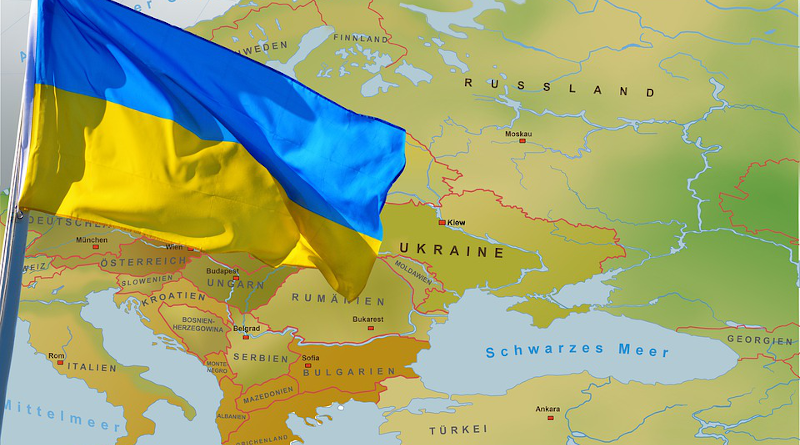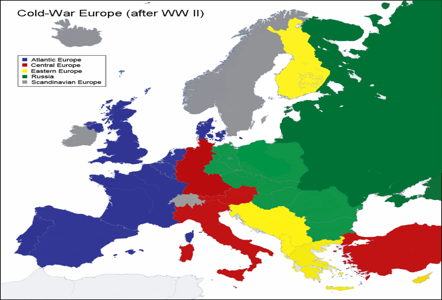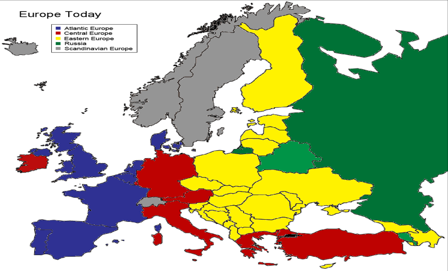
“He who does not wish to speak of capitalism should remain forever silent about Nazism” – I quoted West Germany’s Max Horkheimer some two years ago while discussing the disastrous, cynical and absolutely unnecessary attempts towards the equation of communism with Nazism, of fascism and anti-fascism. Many dismissed that finding, labelling it routinely as yet another intellectual alarmism. But, look at us now: Only one step from the nuclear obliteration. Totalitarian order of destruction
Right than – in that text – I also borrowed from yet another Frankfurter, Herbert Marcuse on the self-entrapment of Western society (discussing the capitalism’s totalitarian order of destruction in each of its forms). Back in 1960s, it was him labelling as “repressive tolerance” if someone in future ever considers a dangerous and ahistorical equitation between Nazism and anything else, least with Communism. Regrettably enough, that future of de-evolution started pouring in by 1990s: It was manifested in the decontextualization coupled with psychologization which eventually culminated in the current Covid-19 iron fist and the binary categorisations over Ukraine. L’avenir est comme le reste: il n’est plus ce qu’il était (the future is no longer what it used to be), as Paul Valéry ironically remarked.
Umberto Eco – in his ur-fascism of 1995 – of course, didn’t see the entire world arrested on one pathogen, one narrative about it, one solution mandated for all (like the mantra of escalation as the only solution for Ukraine), along with suppression of any debate about it. To say; depolitization as the shortest way to dictatorship. Back then in mid-1990’s, Eco didn’t visualise it but he well sensed where it might, but should never go: Trivialisation of our important contents will brutally hit us back – for instance funning the emotional charge in lieu of provable facts. See the rapid deterio-ration of an elaborate, hundred years-old, commonly agreed humanitarian law and a living culture of human rights into a legalisation and institutionalisation of racism – firstly in labour and migration affairs, and by now in refugee management matters, too.
(Immunisation of herd – as tirelessly agitated via media, inevitable ends up in herd loyalty: From pandemia to plundermia, from discussion to binarization. The 1930s are powerful reminder: From Reichstags Fire to Kristallnacht and on, and on, and on.)
Here we are today; 77 years after the glorious Victory Day, fighting (again) invisible enemy within. Therefore, the antifascist fundaments of modern Europe and its best living edifices: – Nurnberg principles, the UN Charter and Helsinki spirit, are today relevant more than ever. This is not our (political) choice, it is the only way to survive. Surely, any equitation attempt is a beginning of infection. And the (decontextualising, aculturalizing, hence dehumanising) immuno-fascism, be it one of 1930’s or of 2020’s always starts with a silence. Silence, which is both an acceptance and accomplice. In vain is a self-comforting excuse of othering; Wir wussten nicht (it was others, not us).
To prevent it, revisiting the most relevant chapters of our near history is worth of doing. Or as the grand Wiz of the EU, Jean Monnet used to say: if you have an unsolvable dilemma – enlarge the context.
No llores porque ya se terminó, sonríe porque sucedió (2)
In fact, the 1930s were full of public admirations of and frequent official visits to an Austrian-born Hitler. It was not only reserved for the British royal family (e.g. Edward VIII), but for many more prominents from both sides of the Atlantic (e.g. Henry Ford). By 1938 in Munich, this ‘spirit of Locarno’ has been confirmed in practice when French President Daladier and British PM Chamberlain (Atlantic Europe) jointly paid a visit to Germany and gave concessions – practically a free hand – to Hitler and Mussolini (Central Europe) on gains in Eastern Europe (Istria, Czechoslovakia and beyond). Neither Atlantic Europe objected to the pre-Munich solidification of Central Europe: Hitler–Mussolini pact and absorption of Austria, following a massive domestic Austrian support to Nazism of its well-educated and well-informed 719,000 members of the Nazi party (nearly a third of a that-time total Austrian electorate), as well as a huge ring of sympathizers. In a referendum organised by the Austro-Nazis a month after the Anschluss, 99.7% of Austrians voted ‘Yes’ to annexation. (3)
By brokering the Ribbentrop-Molotov non-aggression deal between Berlin and Moscow, but only a year after the Munich-shame – in 1939 (incl. the stipulations on Finland, Baltic states, as well as Poland that already participated in the partition of Czechoslovakia), Stalin desperately tried to preempt the imminent. That was a horror of an uncontrolled expansion of Central onto Eastern Europe and closer to Russia – something already largely blessed and encouraged by Atlantic Europe.
However, it should be kept in mind that for the very objective of lebensraum policy (character and size of space needed for Germanophones to unhindered, live and prosper), the Jews, Roma and behavioristic minorities were the non-territorial obstacle. However, Slavs and their respective Slavic states in Eastern Europe were the prime territorial target of Hitler-led Central Europe’s ‘final solution’. Therefore, no wonder why so much fifth column crop among Slavs. For the speeding and smoothening of the lebensraum objective, Quisling was needed as PM in Norway, but Slavic quisling-elites were cattled in each and every of that time major Slavic states – useful idiots in Poland, in Ukraine, in Czechoslovakia, in Yugoslavia, in Bulgaria, etc.
This chapter would be definitely one of the possible spots for a thorough examination, if we only wish to diligently elaborate why Atlantic and Scandinavian Europe scored so much of Nazi-collaboration while Eastern and Russophone Europe opposed and fiercely resisted. (4)
For some 300 years, Russia and the Ottomans – like no other European belligerents – have fought series of bitter wars over the control of the Black Sea plateau and Caucasus – sectors, which both sides (especially the Ottomans) have considered as geopolitically pivotal for their posture. Still, neither party has ever progressed at the battlefield as to seriously jeopardize the existence of the other. However, Russia has experienced such moves several times from within Europe. Three of them were critical for the very survival of Russia, and the forth was rather instructive: the Napoleonic wars, Hitler’s Drang nach Osten, the so-called ‘contra-revolutionary’ intervention (5), and finally the brief but deeply humiliating war with Poland (1919-21).
In absence of acceptance, quest for the strategic depth
Small wonder, that in 1945, when Russians– suffering over 20 millions of mostly civilian casualties (practically, an extermination of the entire population in many parts of the western Soviet Union), and by far the heaviest continental burden of the war against Nazism – arrived on wings of their tanks and ideology to Central Europe, they decided to stay (6). Extending their strategic depth westwards–southwestwards, and fortifying their presence in the heart of Europe (7), was morally an occupation. Still, it was geopolitically the single option left, which Stalin as a ruthless person but an excellent geo-strategist perfectly understood.

Just a quick look at the geographic map of Europe would show that the low-laying areas of western Russia, Belorussia, Ukraine and Eastern Europe are practically non-fortifiable and indefensible. Their topography exposes the metropolitan area and city of Moscow to an extreme vulnerability. So, the geostrategic dictatum is that in absence of any deep canyon, serious ridge or mountain chain, the only protection is either a huge standing army (expensive and badly needed in other corners of this vast country) and/or an extension of the strategic depth.
Indeed, if we truly want to elaborate on why Atlantic and Scandinavian Europe bred so much obedience and Nazi-collaboration (with Central Europe) and largely passively stood by, while Eastern and Russophone Europe (solely) fiercely resisted and fought, we should advisably examine the financial, moral, demographic and politico-military cost-benefit ratio of the WWII, too. The subsequent, sudden and lasting Cold War era has prevented any comprehensive scientific consensus. The unbiased, de-ideologized and objective view on the WWII was systematically discouraged. Soviets consistently equated Nazism and imperialism while the US, for its part, equated fascism and communism. Until this very day, we do not have a full accord on causes and consequences of events in years before, during and after the WWII (8). Therefore the paradox – the holocaust denial is a criminal offense, but all other important things surrounding Nazism and its principal European victims; Slavs and their states, are tentative and negotiable, elastic and eligible for a periodic political re-engineering.

The same applies to the comparative analysis of the economic performance of East and West (9). E.g. was the much-celebrated Truman’s Marshall aid to the post-WWII western Europe, originally meant to be the US reimbursement to the Soviets for the enormous burden they took throughout the WWII – the financial assistance that was repeatedly promised by Roosevelt to Stalin, but never delivered past his death in spring 1945? Saturated by the Nazi Germany beyond comprehension, the Soviet Union was rebuilding alone itself and Eastern Europe, while the moderately damaged Western Europe got – including Germany – a massive, ideologically conditioned, financial help.
In a nutshell; if we disaggregate Europe into its compounding historical components, it is safe to say the following: The very epilogue of both WWs in Europe was a defeat of the Central (status quo challenger) against Atlantic Europe (status quo defender). All this with the relatively absent, neutral Scandinavian Europe, of Eastern Europe being more an object than a subject of these mega-confrontations, and finally with a variable success of Russophone Europe.
Finally, back to Franco-German post-WWII re-rapprochement.
Obviously, that was far more than just a story about the two countries signing d’accord. It truly marked a final decisive reconciliation of two Europes, the Atlantic and Central one. The status quo Europe has won on the continent but has soon lost its overseas colonies. Once realizing it, the road for ‘unification’ of the equally weakened protagonists in a close proximity was wide open. This is the full meaning of the 1961Elysée.
Why does the de-trivialization, de-psychologization, re-historization and re-contextualization matters today? Because, our further simplification breads binarization, and that is a road for escalation beyond the point of return. What is at stake are not anymore (only) the principles, but our very survival.
Notes:
In translation it means: “We didn’t know”. This was a classic phrase of denial and excuse used by many Germans and Austrians after being confronted with the mass atrocities and WWII war crimes evidences.
Much quoted line of Gabriel García Márquez; from Spanish: ‘Don’t cry because it’s over, smile because it happened’.
In his luminary piece, Rolf Soderlind states: “…unlike other countries occupied by the Nazis in the ensuing WWII, Austria embraced the March 12, 1938 invasion with an enthusiasm that surprised the Germans and which still affects the country. The role as victim-turned-accomplice in Hitler’s crimes against humanity was a taboo for decades after the war in Austria… After all, Hitler was born in Austria, which historians say was the cradle of Nazism at the start of the century. Hitler merely took the ideas with him to Munich and, later, Berlin.” No wonder that a disproportionately high number of Austrians, including war criminals such as (Adolf) Eichmann and (Ernst) Kaltenbrunner, took active part in the systematic exterminations of Slavic peoples, Jews, Romas and other racially or politically ‘impure’ segments, manly from the Europe’s East. “Austrian Nazis, quickly proving to be even more brutal than their ruthless German masters, hit the streets after the invasion to intimidate, beat up and rob mainly Jews but also to settle the account with Social Democrats and Communists — their political opponents.” – describes Soderlind. “This was not on Hitler’s orders. It was a spontaneous pogrom. It was popular among Austrians to go after the Jews,” says Gerhard Botz, professor of contemporary history at the University of Vienna. On the account, American journalist Shirer reported: “For the first few weeks the behavior of the Vienna Nazis was worse than anything I had seen in Germany,” and concludes: “there was an orgy of sadism.” A day after, already by March 13, 1938, Jews and other racial or political ‘inappropriates’ were forced to scrub the pavements and clean the gutters of the Austrian capital, the elegant cafe society that was world-wide admired as a stage for classical music, wise humanity and a shining example of Baroque architecture. “As they worked on their hands and knees with jeering storm troopers standing over them, crowds gathered to taunt them,” Shirer wrote. While the Nazi Party was banned in post-war Austria, most veteran Nazis were highly educated people who found a new career in politics and government. Professor Wolfgang Neugebauer says: “They could not remove the entire leadership, because then the state would no longer be able to function. Even in the first government of Social Democratic (and Jewish) Chancellor Bruno Kreisky in 1970s, four ministers were former Nazis… Chancellor Franz Vranitzky in a speech to parliament in 1991 became the first Austrian leader to admit that his country was a servant of Nazism.” Interestingly, German and Austrian leaders apologized to Israel (or generally to Jews) repeatedly, but not really to the peoples of Eastern Europe who were by far the largest Nazi victim. Illuminating the origins of wealth of Central Europe, Neugebauer admits: ”It was not until 1995 (time when all three Slavic multinational states have undergone the dissolution, and disappeared from the map, rem. aut.) that Austria started paying compensation to surviving victims of Austrian Nazi aggression.” In the same fashion, Germany – considered as the Europe’s economic miracle – in essence an overbearing Mitteleuropear that dragged world into the two devastating world wars, is a serial defaulter which received debt relief four times in the 20th century (1924, 1929, 1932 and 1953). E.g. by the letter of London Agreement on German External Debts (Londoner Schuldenabkommen) over 60% of German reparations for the colossal atrocities committed in both WW were forgiven (or generously reprogramed) by their former European victims (incl. devastated Greece and Yugoslavia).
One of the possible reasons was a fact that the Atlanstist nobility, wealth-clans and dynasties were mingled and intermarried with those same from Central and Scandinavian Europe. That was only sporadic in case of Eastern Europe, and totally absent in case of Russophone Europe.
The 6-year-long insurgencies was largely financed and inspired by Western Europe as an overt ‘regime change’ intervention. It came at the time of the young Bolshevik Russia, and it subsequently saturated the country, bringing the unbearable levels of starvation and hunger up to cases of cannibalism, especially in Ukraine. It took away 5 million mostly civilian lives, and eventually set the stage for a ‘red terror’.
The same applies to the Atlantic (Anglo-French and American) lasting occupation of Central Europe, which along with the Soviet one was the only guaranty for the full and decisive de-Nazification of the core sectors of continental Europe.
With the politico-military settlement of the Teheran and Yalta Conference (1943), and finally by the accord of the Potsdam Conference (1945), the US, UK and the SU unanimously agreed to reduce the size of Germany by 25% (comparable to its size of 1937), to recreate Austria, and to divide both of them on four occupation zones. The European sections of the Soviet borders were extended westwards (as far as to Kaliningrad), and Poland was compensated by territorial gains in former Eastern Prussia/Germany. The Americans and Britons in Potsdam unanimously confirmed the pre-WWII inclusion of the three Baltic republics into the Soviet Union, too. Practically, Russians managed to eliminate Germany from Eastern Europe (and of its access to central and eastern portions of Baltic, too), and to place it closer to the Atlantic Europe’s proper.
Sadly enough, most of the popular Atlantist literature or movies elaborating on topics of the WWII are biased and misleading on the role of the Red Army, and are generally disrespectful towards the enormous suffering of the Soviet and Yugoslav peoples at that time.
Comparing and contrasting the economic performance of East and West, many western scholars in 1950s and 1960s argued that the Soviet socio-economic model is superior to that of its western archrival. The superpower’s space-race was usually the most quoted argument for this claim. Indeed, some dozens of Soviet space-race victories were so magnificent that it was impossible to hide them, as the ideological dictum would suggested. E.g. the first orbiting satellite (Sputnik 1, 1957); the first animal, the first man, and the first women in orbit (Laika 1957, Gagarin 1961, Tereshkova 1963); the first over-24 hours stay in space (Titov, 1961); first images of the dark side of moon (1959); the first man-made device to enter the atmosphere of another planet, and to achieve the soft landing on Venus and images sent from there (Venera 4, 1967; Venera 7, 1970); the first space-walk (Leonov,1965); the first space station (Salyut, 1971); the first probe to ever land on Mars (Mars 3, 1971); the first permanently manned space station including the longest stays in space (Mir, 1989-99), etc. 